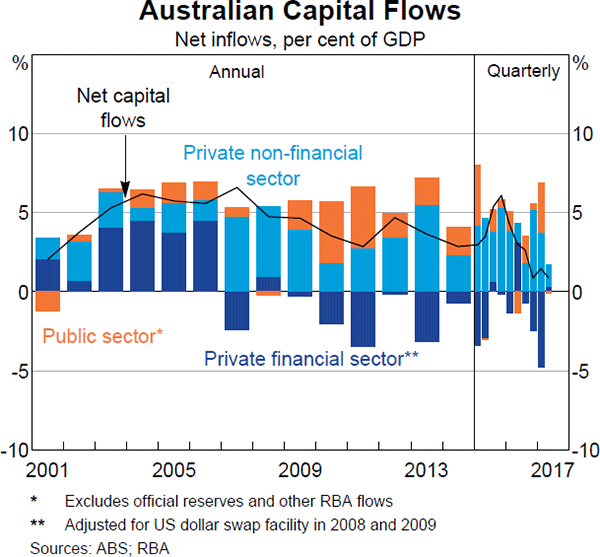Statement on Monetary Policy – November 2017 2. International and Foreign Exchange Markets
Central bank policies have remained a key focus of financial markets in recent months. Central banks in a few advanced economies have continued to adjust policies so as to be less accommodative and market participants have brought forward their expectations for increases in policy rates. This has occurred as spare capacity in economies has diminished further. Partly as a result, yields on sovereign bonds in advanced economies have risen from their recent lows.
Meanwhile, prices of riskier assets have risen strongly. Many equity market indices have reached record highs and credit spreads on corporate bonds have tightened from already narrow levels. At the same time, both realised and implied financial market volatility have remained subdued. As well as a search for yield in the low interest rate environment, these outcomes reflect improved economic conditions, strength in corporate earnings and expectations for increased fiscal stimulus. They also reflect the low inflation environment and the view that central banks will remove policy accommodation only gradually. Corporations have taken advantage of these favourable financial conditions to raise funds in bond and equity markets. Bond issuance, particularly in US dollars, is around its highest level for several years.
Exchange rates have also responded to changing expectations for monetary as well as fiscal policy. Although the US dollar has appreciated a little in recent months, it remains lower than it was at the end of 2016. While the Australian dollar has depreciated a little of late, it remains higher than its early-2016 trough in trade-weighted terms.
Central Bank Policy
The US Federal Reserve continues to remove monetary accommodation. It began to reduce the size of its balance sheet in October and stated that it will continue to do so in ‘a gradual and predictable manner’ over the next few years. The Federal Open Market Committee (FOMC) projected that it is likely to increase the policy rate by another 25 basis points this year and by a further 75 basis points in 2018. Most members of the FOMC believe that inflation is being held down by transitory factors and that inflationary pressures will build as the labour market continues to tighten. In contrast, some other members are concerned that low inflation may reflect structural factors and could be more persistent. While market participants' expectations for the level of the policy rate have increased recently, they remain below the FOMC's median projections (Graph 2.1).
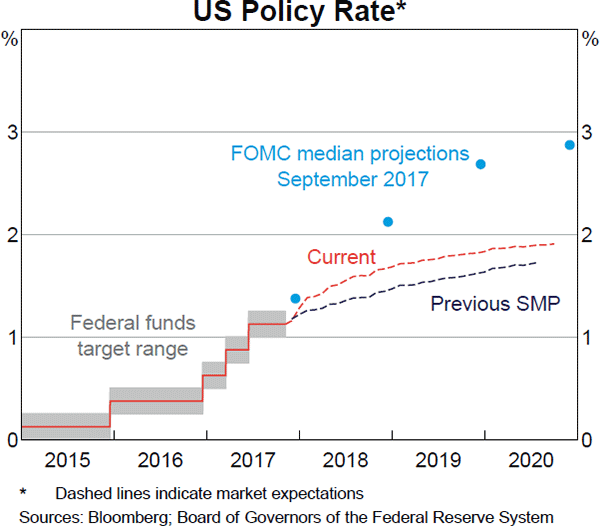
At its October meeting, the European Central Bank (ECB) announced that it will extend its asset purchase program until September 2018 but will reduce the pace of asset purchases from €60 billion to €30 billion per month from January 2018 (Graph 2.2). The ECB stated that it will extend the program even further if necessary for inflation to rise towards target on a sustained basis. It also stated that it will continue to reinvest the receipts from maturing assets and keep interest rates at present levels until well past the end date of net purchases.
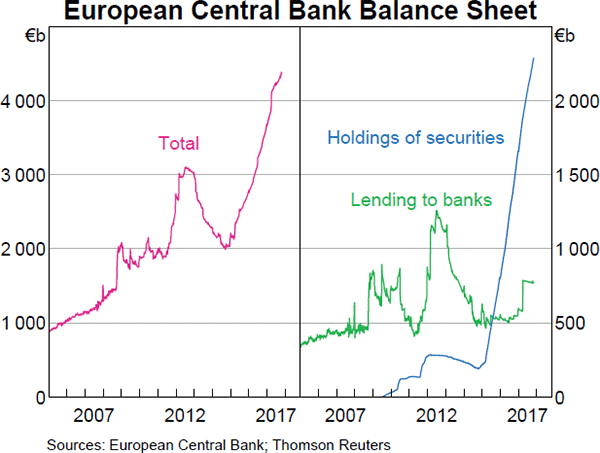
The Bank of Canada (BoC) increased its policy rate by a further 25 basis points in September, earlier than many market participants had anticipated. At its October meeting, the BoC lowered its near-term forecast for inflation, citing the strength in the Canadian dollar, and noted that it will be cautious in making further adjustments to the policy rate. The Bank of England increased its policy rate in November, noting diminishing economic slack and above-target inflation. However, it also noted that any further increases in the policy rate are likely to be limited and gradual. Market participants currently expect higher policy rates in Canada and the United Kingdom than they did a few months ago (Graph 2.3).
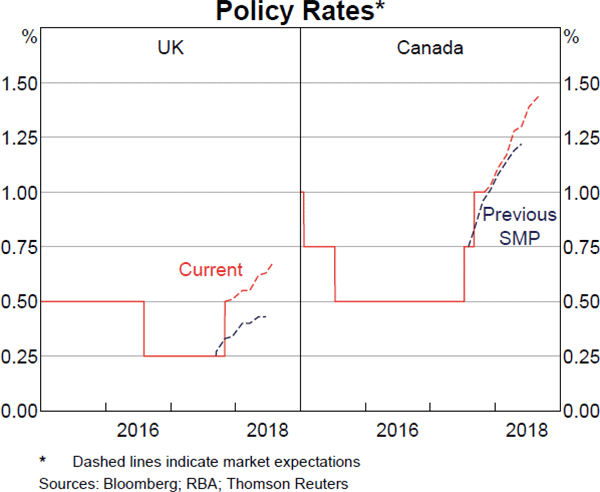
The Bank of Japan (BoJ) has left its policy settings unchanged since late last year. While it intends to purchase around ¥80 trillion in Japanese government bonds annually under its policy of ‘yield curve control’, purchases actually needed to maintain yields on 10-year bonds around zero have fallen below this pace at times in recent months. The BoJ expects inflation to pick up towards its target over the coming years as economic growth remains above potential.
In contrast to central banks in advanced economies, many central banks in emerging markets have reduced their policy rates in response to an easing of inflationary pressures. In Brazil, Indonesia and Russia, policy rates have been lowered significantly over the past year or so (Table 2.1). The Reserve Bank of India has also reduced its policy rate this year, though it has noted upside risks to inflation.
| Policy rate Per cent | Most recent change | ||
|---|---|---|---|
| Euro area(a) | −0.40 | ↓ | Mar 16 |
| Japan(a) | −0.10 | ↓ | Jan 16 |
| United States(b) | 1.125 | ↑ | Jun 17 |
| Australia | 1.50 | ↓ | Aug 16 |
| Brazil | 7.50 | ↓ | Oct 17 |
| Canada | 1.00 | ↑ | Sep 17 |
| Chile | 2.50 | ↓ | May 17 |
| India | 6.00 | ↓ | Aug 17 |
| Indonesia | 4.25 | ↓ | Sep 17 |
| Israel | 0.10 | ↓ | Feb 15 |
| Malaysia | 3.00 | ↓ | Jul 16 |
| Mexico | 7.00 | ↑ | Jun 17 |
| New Zealand | 1.75 | ↓ | Nov 16 |
| Norway | 0.50 | ↓ | Mar 16 |
| Russia | 8.25 | ↓ | Oct 17 |
| South Africa | 6.75 | ↓ | Jul 17 |
| South Korea | 1.25 | ↓ | Jun 16 |
| Sweden | −0.50 | ↓ | Feb 16 |
| Switzerland(b) | −0.75 | ↓ | Jan 15 |
| Thailand | 1.50 | ↓ | Apr 15 |
| Turkey | 8.00 | ↑ | Nov 16 |
| United Kingdom | 0.50 | ↑ | Nov 17 |
|
(a) Marginal rate paid on deposits at the central bank Sources: central banks; RBA; Thomson Reuters |
|||
Sovereign Debt Markets
Government bond yields have risen recently as market participants have brought forward their expectations for the withdrawal of monetary policy accommodation (Graph 2.4). The rise in yields has been most significant in Canada, where expectations for policy rates have increased the most. In the United States, the effect of the policy actions of the Federal Reserve and prospects for increased fiscal stimulus have been partially offset by lingering concerns of market participants that low inflation may persist. In the euro area, the increase in yields on German government bonds has been limited by expectations that the ECB will remove policy accommodation at a slower pace than many other central banks. Yields on other euro area government bonds have generally moved in line with German bunds, although yields on Spanish government bonds rose a little more in response to the push for independence in Catalonia. In Japan, yields on 10-year government bonds have remained close to the BoJ's target of around 0 per cent under its policy of ‘yield curve control’.
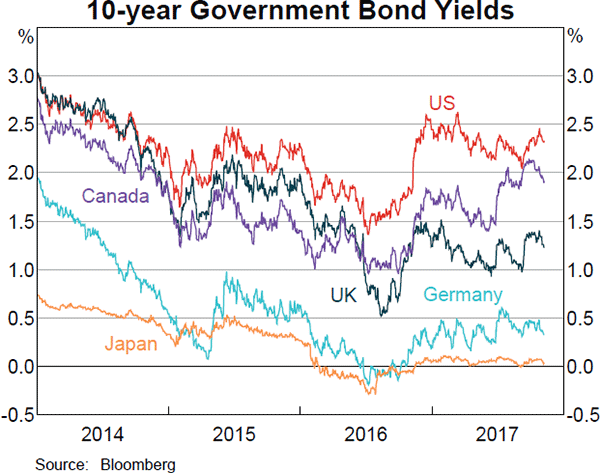
Notwithstanding their recent increases, government bond yields in many advanced economies remain very low by historical standards. This partly reflects the large holdings and ongoing purchases of government bonds by central banks. However, net purchases by central banks will decline significantly over the next year as the US Federal Reserve continues to reduce the size of its holdings and the ECB slows the pace of its purchases (Graph 2.5). Nonetheless, the US Federal Reserve and market participants generally anticipate that any resulting change in government bond yields will be small.
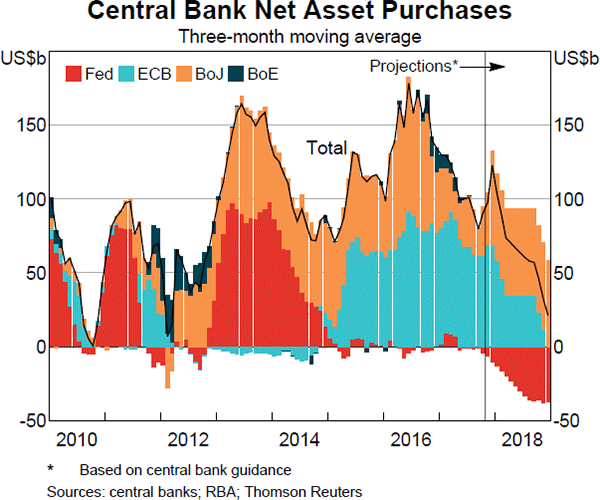
Although yields on government bonds in emerging markets have also risen in recent months, they have declined significantly over 2017 (Graph 2.6). This decline reflects a decrease in inflation and the associated lowering of monetary policy rates in many emerging markets. In addition, investor sentiment towards emerging markets has been buoyed by the improvement in global economic conditions and perceptions that emerging economies are generally less vulnerable to a sudden withdrawal of external funding than they were during the 2013 ‘taper tantrum’ in the United States. These perceptions stem, in part, from reductions in the current account deficits and increases in the levels of foreign exchange reserves of those countries that had appeared most vulnerable to capital flight. In addition, the perceived likelihood of capital flight from emerging markets is low because market participants see little risk of a sharp rise in inflation or interest rates in advanced economies.
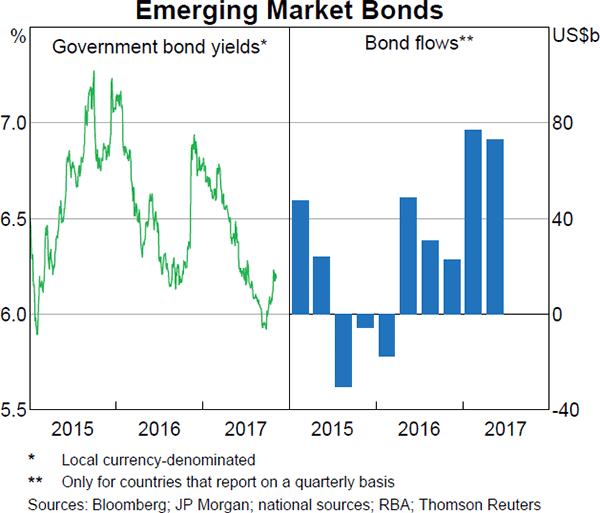
Credit Markets
Credit market conditions for corporations remain highly favourable. Yields on corporate bonds and their spreads to government bond yields are low (Graph 2.7); in some market segments spreads are at their lowest levels since the financial crisis. These accommodative conditions for corporations partly reflect strong investor demand for corporate debt. Demand for corporate bonds has been buoyed by a recovery in corporate earnings – owing to stronger economic growth – and the prolonged low level of risk-free rates globally, which have made it easier for firms to service their debt and reduced their risk of default. Reflecting this, default rates in both the United States and the euro area have declined this year and the number of firms receiving upgrades to their credit ratings has increased (Graph 2.8). Nonetheless, as the Bank's October 2017 Financial Stability Review noted, some investors may be underestimating the downside risks they face.
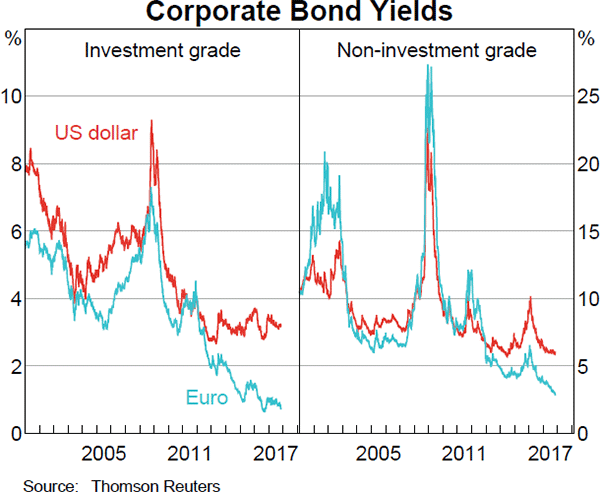
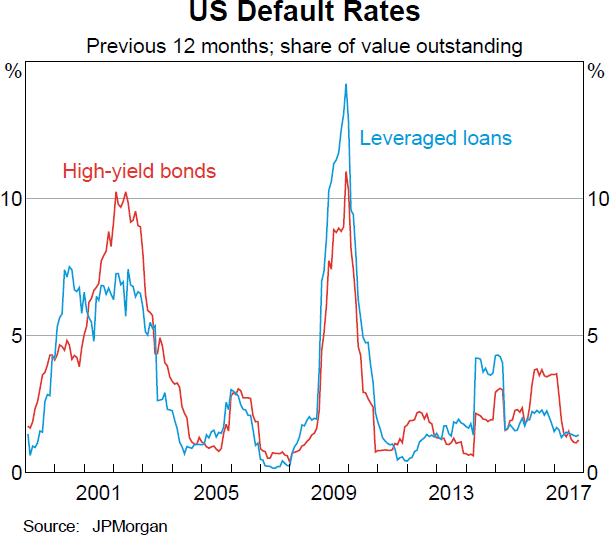
Corporations have taken advantage of the demand for corporate debt and low interest rate environment by increasing bond issuance. Global issuance in 2017 has been substantial and follows strong issuance in 2016 (Graph 2.9). As a result, measures of corporate leverage have risen in many regions in recent years.
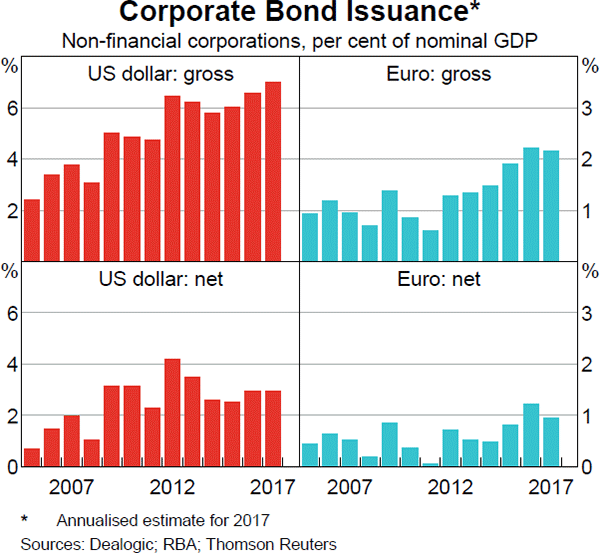
Borrowing costs in short-term US dollar money markets have risen alongside increases in the federal funds rate. Nonetheless, the cost of borrowing US dollars in money markets on an unsecured basis, relative to the risk-free rate, declined sharply early in the year and has remained low (Graph 2.10). The additional cost of borrowing US dollars in exchange for other currencies is also low relative to late last year, though recently it has increased somewhat.
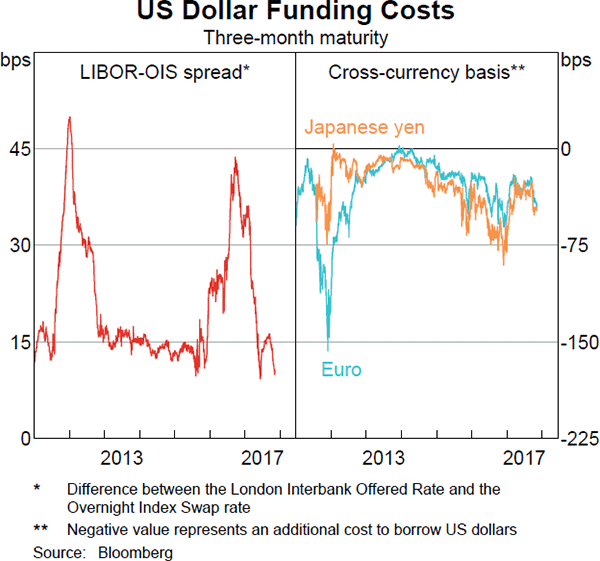
Equity Markets
Global share prices have risen significantly over 2017, particularly in emerging markets (Graph 2.11). The rises reflect higher corporate earnings, which have been supported by the improved economic conditions, and the low interest rate environment. In the United States, aggregate corporate earnings are forecast to rise substantially in 2017 for the first time in three years. Nonetheless, the rise in share prices has generally outpaced the rise in near-term earnings. As a result, measures of valuation, such as the price-earnings ratio, have increased in many share markets to around their highest levels in more than a decade and, as noted in the Bank's October 2017 Financial Stability Review, some asset prices appear elevated (Graph 2.12). However, the high level of valuations is broadly consistent with expectations of ongoing strength in earnings over the next few years and the low level of interest rates.
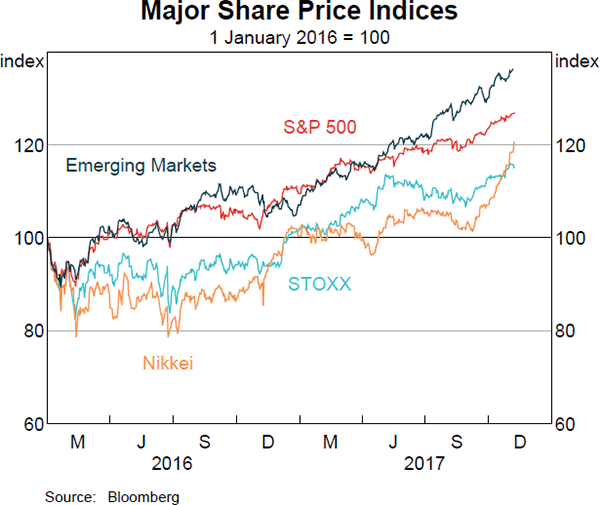
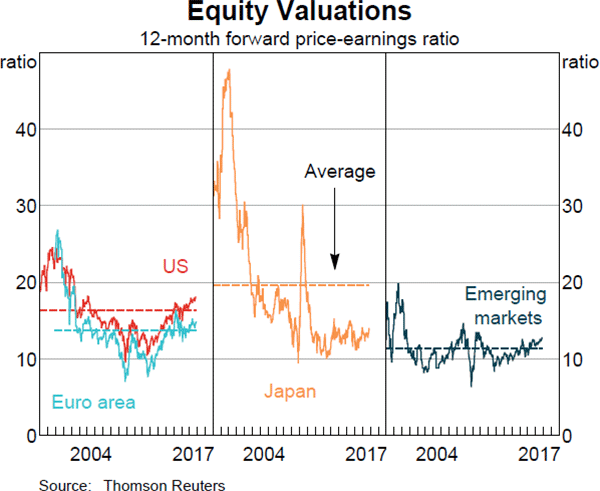
Chinese Financial Markets
Chinese government and corporate bond yields have increased recently because market participants expect that the authorities will renew efforts to address concerns around leverage in the financial system. Prior to these moves, conditions in Chinese financial markets had been little changed since the middle of the year (Graph 2.13). This followed a period of rising financial market interest rates that accompanied regulatory measures implemented by Chinese authorities in response to concerns about financial stability risks (see RBA (2017), ‘Box B: Recent Developments in Chinese Financial Regulations’, Statement on Monetary Policy, August, pp 27–30 for details). These earlier measures appear to have had some effect in reducing vulnerabilities in some areas of the financial sector (see ‘International Economic Developments’).
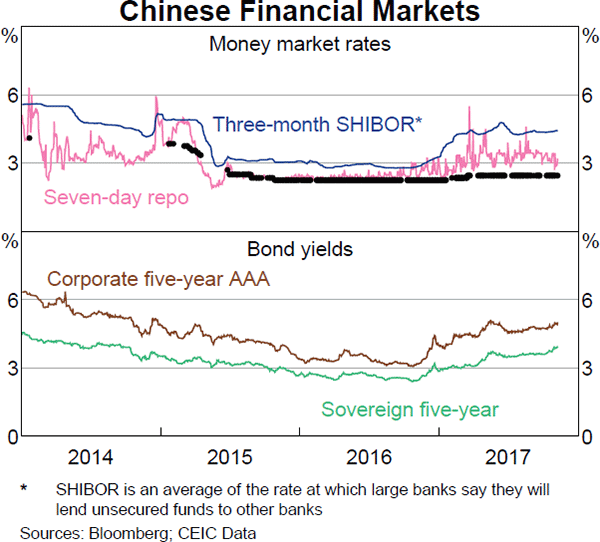
The People's Bank of China (PBC) announced a reduction in reserve requirement ratios (RRR) from 2018 for banks that meet certain targets for lending to small businesses and the agricultural sector. The PBC subsequently reiterated its intention to implement a prudent and neutral monetary policy, while keeping liquidity stable, and has said that the RRR announcement does not reflect a shift in its monetary policy stance.
Chinese share prices have increased further during the second half of this year and are around one-third higher over 2017 to date (Graph 2.14). Equity prices have been supported by a general improvement in corporate profitability amid generally better-than-expected economic conditions. An increase in net investment flows into equities from Hong Kong has also contributed. Partly in response to these flows, the difference between share prices on the mainland (in the A-share market) and in Hong Kong (in the H-share market) of Chinese companies with a dual listing has widened.
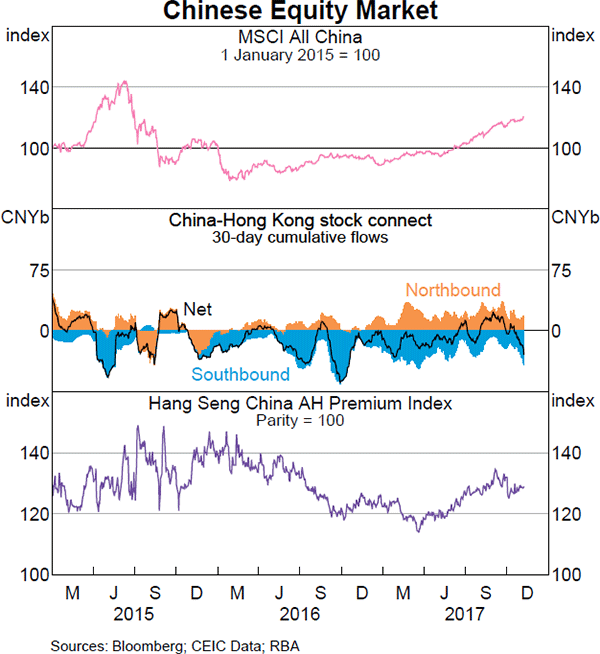
There has been a change in behaviour this year in response to policies related to capital flows and the exchange rate. China has experienced small net private capital inflows over 2017 to date (Graph 2.15). Private capital inflows have been driven by an increase in foreigners' holdings of Chinese renminbi (RMB) with Chinese banks, as well as an increase in Chinese corporations' borrowing in foreign currency. This is in contrast to the trend over the previous few years, when Chinese firms had opted to repay debts denominated in foreign currency, contributing to large net capital outflows. Partly reflecting the turnaround in net capital flows, the value of the PBC's foreign currency reserves has been little changed over the year to October, at a bit over US$3 trillion.
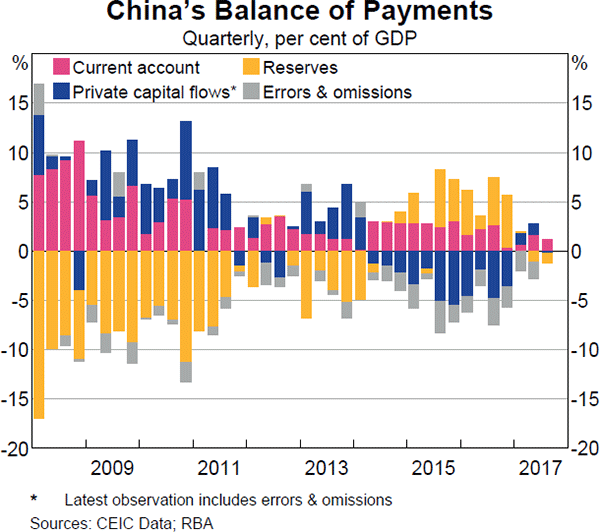
The noticeable appreciation of the RMB against the US dollar over 2017 to date has both supported and reflected net capital inflows (Graph 2.16). The appreciation has reduced the perceived currency risk associated with holding assets denominated in RMB and increased the attractiveness of borrowing in foreign currency. Much of the appreciation over the year has been associated with broad-based depreciation of the US dollar (notwithstanding the slight appreciation of the US dollar over the past couple of months, see Foreign Exchange); the RMB is little changed on a trade-weighted (TWI) basis. Volatility in the RMB has picked up recently, in line with the PBC looking to gradually allow more flexibility in the exchange rate. Consistent with this, the authorities recently removed a requirement, introduced in late 2015, which had made it more expensive to sell RMB.
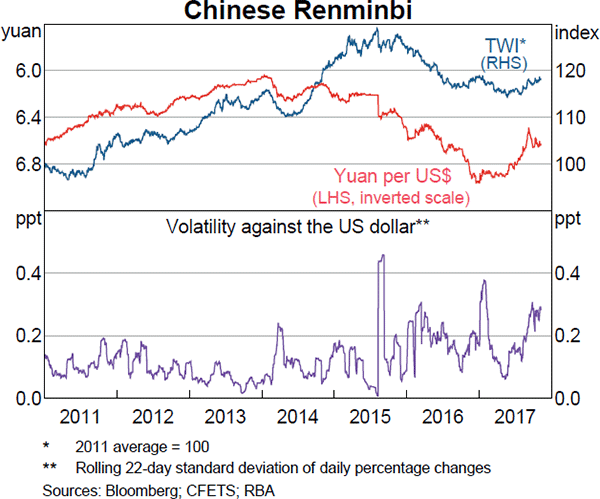
Tighter enforcement of capital controls by the Chinese authorities, which has reduced direct investment outflows, has also contributed to the turnaround in Chinese capital flows. In August, the authorities released rules on overseas direct investment, formalising some of the regulations introduced since late 2016 (see ‘Box B: Chinese Direct Investment in Australia’). While the tighter capital controls might lead to a reduction in Chinese direct investment in Australia, Chinese investment overall makes up only a relatively modest share of the level of total direct investment in Australia.
Foreign Exchange
Expectations for the stance of monetary policy continue to influence exchange rates in advanced economies. Following a broad-based depreciation since the start of the year, the US dollar has recently appreciated a little against a range of currencies (Table 2.2; Graph 2.17). Expectations of tighter monetary policy in the United States as well as renewed prospects for fiscal stimulus have supported the currency. The US dollar appreciation has been particularly pronounced against the Mexican peso, reflecting heightened concerns regarding the future of Mexico's trading relationship with the United States (Graph 2.18).
| Over 2016 | 2017 to date | |
|---|---|---|
| Philippine peso | 6 | 3 |
| Indonesian rupiah | −2 | 0 |
| Brazilian real | −18 | 0 |
| New Zealand dollar | −1 | 0 |
| Swiss franc | 2 | −2 |
| Japanese yen | −3 | −3 |
| Russian rouble | −14 | −4 |
| Indian rupee | 3 | −4 |
| Chinese renminbi | 7 | −5 |
| Canadian dollar | −3 | −5 |
| Malaysian ringgit | 5 | −6 |
| UK pound sterling | 19 | −6 |
| Singapore dollar | 2 | −6 |
| Australian dollar | 1 | −6 |
| New Taiwan dollar | −1 | −7 |
| South Korean won | 3 | −7 |
| Thai baht | −1 | −8 |
| Mexican peso | 21 | −8 |
| Swedish krona | 8 | −8 |
| European euro | 3 | −9 |
| Trade weighted index | 4 | −6 |
|
Sources: Bloomberg; Board of Governors of the Federal Reserve System |
||
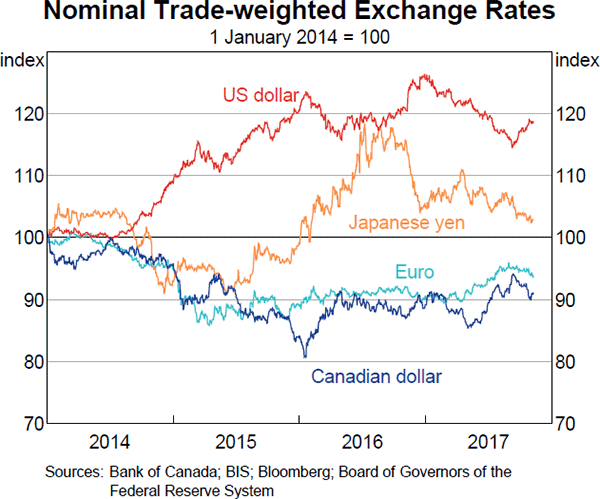
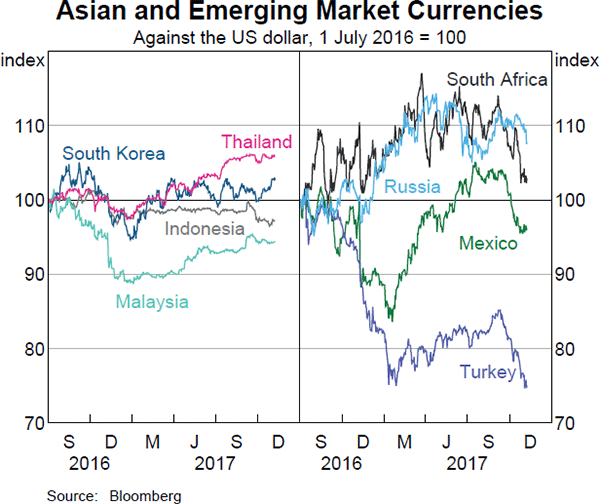
The Canadian dollar has fluctuated alongside evolving market expectations for the timing and extent of changes to monetary policy. It is now around 5 per cent higher since the recent trough in May on a trade-weighted basis. The euro has been little changed in recent months, after appreciating earlier in the year following an easing of political uncertainty and the ECB removing its bias to ease interest rates further. Measures of volatility in foreign exchange markets remain at low levels.
The gross foreign currency reserves of most emerging market economies have increased since the end of 2016 (Graph 2.19). This is consistent with a depreciation of the US dollar over this period, which increased the US dollar value of reserves held in other currencies. The increase in reserves has also generally been larger for those economies that tend to manage their exchange rate more closely against the US dollar.
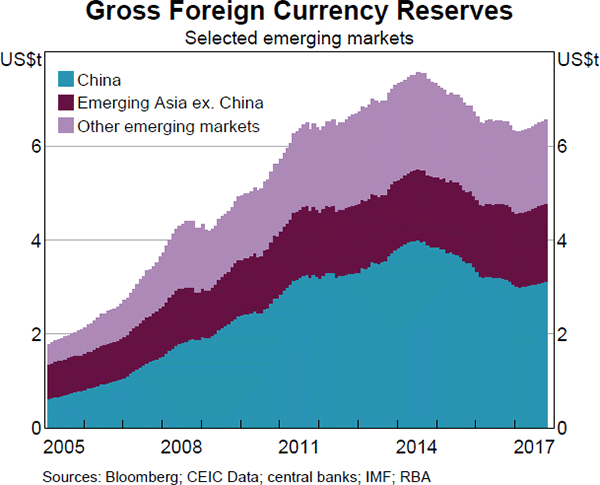
Australian Dollar
Since the start of 2016, the Australian dollar has appreciated against the US dollar and on a trade-weighted basis (Table 2.3; Graph 2.20). Increases in iron ore and coal prices supported the Australian dollar over this period. This more than offset the effect of a narrowing of interest rate differentials between Australian and US government bonds. More recently, the Australian dollar has depreciated slightly, reflecting the broad-based appreciation of the US dollar since early September (see above) and a decline in the price of iron ore.
| Over 2016 | 2017 to date | |
|---|---|---|
| South African rand | −12 | 10 |
| Indonesian rupiah | −3 | 7 |
| US dollar | −1 | 7 |
| New Zealand dollar | −3 | 6 |
| Swiss franc | 1 | 5 |
| Japanese yen | −4 | 4 |
| Indian rupee | 1 | 2 |
| Chinese renminbi | 6 | 2 |
| Canadian dollar | −4 | 1 |
| Malaysian ringgit | 3 | 1 |
| UK pound sterling | 18 | 0 |
| Singapore dollar | 1 | 0 |
| South Korean won | 1 | −1 |
| Thai baht | −2 | −1 |
| European euro | 2 | −3 |
| Trade-weighted index | 2 | 2 |
|
Sources: Bloomberg; RBA |
||
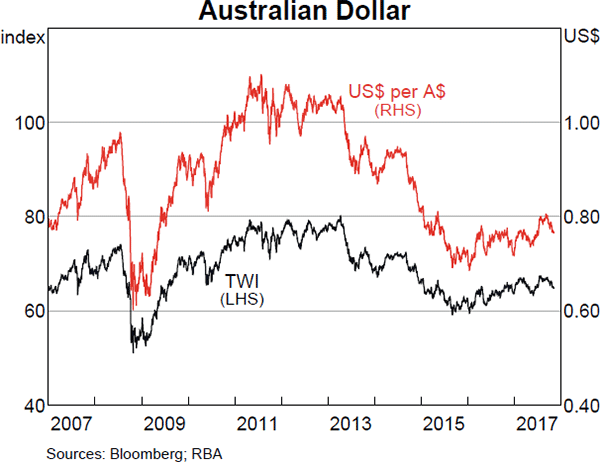
Capital Flows
With a decline in the difference between Australia's saving and investment over recent years, the current account deficit has narrowed to low levels (Graph 2.21). This has coincided with the trade balance moving into surplus owing to higher resource prices and volumes, which have supported export revenues. Australia's ongoing net foreign liability position with the rest of the world (and the repayments that are made due to this position) means that the net income balance has remained in deficit. When the currency composition of assets and liabilities is taken into account, Australia has a net foreign currency asset position. This increases even further when the hedging of foreign currency exposures back into Australian dollars is taken into account (see ‘Box C: Foreign Currency Exposure and Hedging in Australia’ for further details).
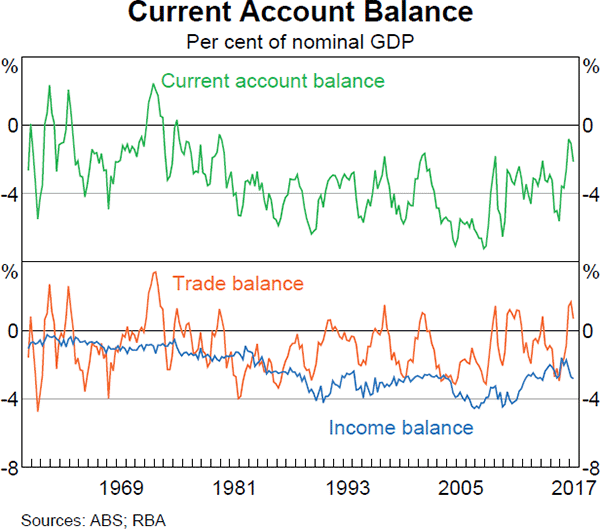
In line with the narrowing current account deficit since early 2016, the extent of net capital inflows to Australia has slowed (Graph 2.22). This has largely reflected a gradual reduction in inflows to the mining sector as the mining investment boom has unwound, although there have been some offsetting inflows to the non-mining, non-financial sector.
